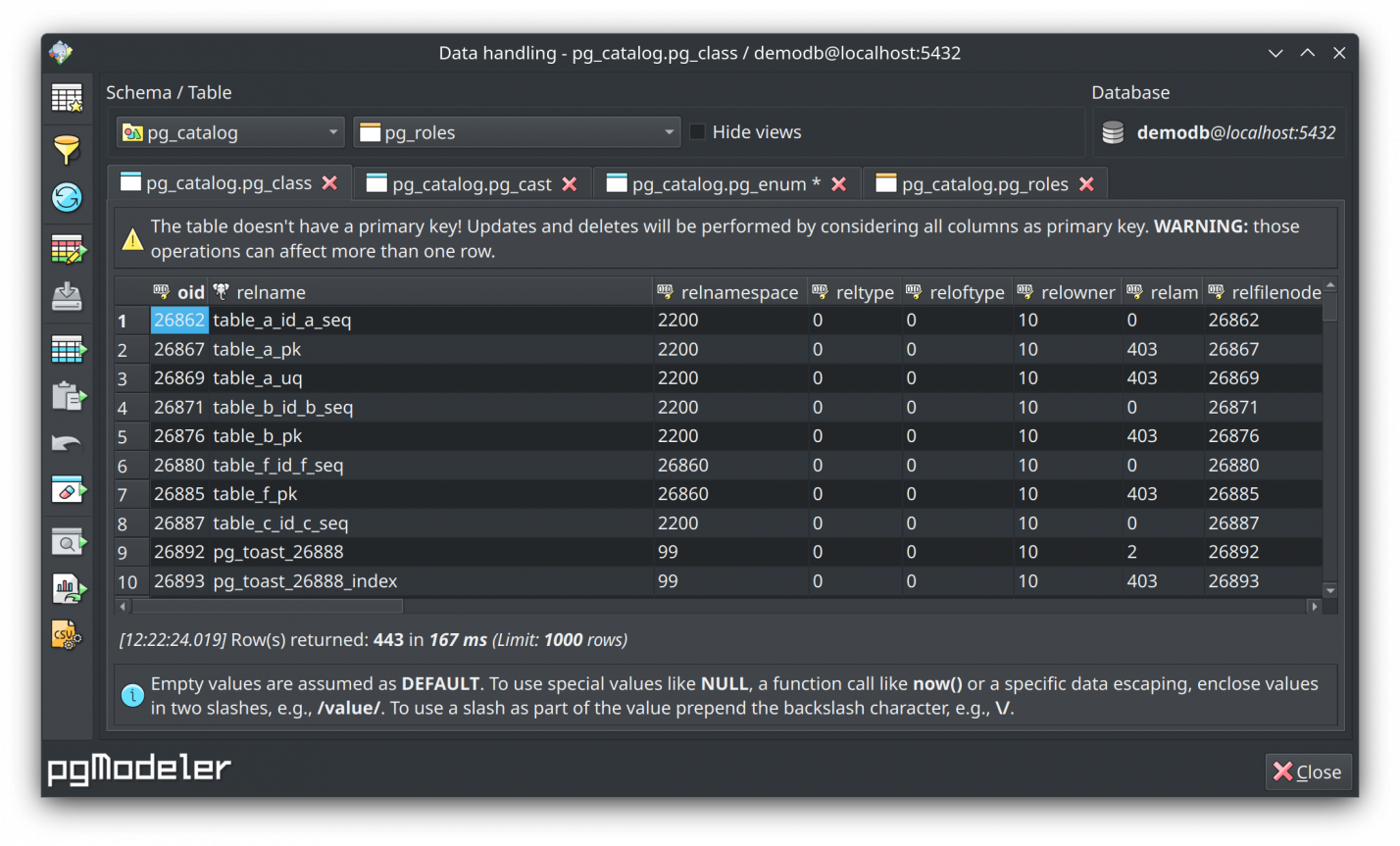pgModeler 2.0.0-alpha is finally here!
The beggining of a new era for the project.
2025

The pgModeler 2.0.0-alpha release introduces significant improvements aimed at enhancing usability, flexibility, and maintainability. One of the most notable changes is the migration of the build system from qmake to CMake. The user interface has also received a major update. While still a work in progress, this alpha version introduces a refreshed logo, updated icon colors with a flatter and more colorful style, and the integration of the configuration form and core tools — diff, import, export, and fix — directly into the main window. The diff tool has been enhanced with a new model-to-model comparison mode, allowing offline comparisons between two loaded database models and generating the corresponding SQL diff for later application. Import and export tools have undergone similar refinements. Components have been reorganized for a cleaner interface, allowing users to freely choose which models to operate on, rather than being restricted to the active model. This ensures a smoother and more intuitive experience across all data handling operations. For more details, please read the full post; don't skip it!
pgModeler 1.2.0 is finally ready!
Closing the 1.x development cycle.
2025
pgModeler’s new release delivers 72 features, 93 improvements, and 74 fixes. Debugging capabilities now include dedicated log tabs for import and diff operations. The user can now visualize the SQL code from multiple selected objects. Relationships now generate indexes on foreign-key columns. The layer management now supports synchronizing visibility between tables and their relationships. Export operation can run transactionally for atomic DDL execution (except database and tablespace creation commands). The SQL editor's code completion now handles ALTER/DROP commands and ORDER BY columns. In the manage view, the handling form now uses a tabbed interface for better data visualization. The schema microlanguage supports escaped metacharacters and file includes. Data dictionaries can now be exported to Markdown format. The configuration files are now migrated more smoothly from prior major versions. The Plus edition adds plugins for quick constraint/index/relationship creation and query variable testing. The support for Qt 6.2 and 6.3 was dropped to simplify the codebase maintenance, and now Qt 6.4+ is required. Those and many other key changes are fully detailed in this post, so don't skip them!
I proudly announce pgModeler 1.2.0-beta1!
UX/UI enhancements, pgModeler Plus, and much more!
2025
This release delivers some cool improvements to database modeling capabilities. The SQL source code editor has been upgraded with per-instance line wrapping controls and a built-in search/replace widget, centralizing these functions while removing redundant search implementations across the application. The debugging workflows are enhanced through dedicated output tabs in both database import and diff forms, providing clearer visibility into operations. When running in debug mode, the import form now remains open, allowing users to examine the executed commands and generated objects' code. The diff tool reintroduces the forced object re-creation option with added granularity - users can now select specific object types for re-creation through a dedicated popup menu in GUI. The SQL generation offers finer control by permitting disabled code segments to be included in output SQL scripts when needed. The extension objects received a better child object tracking (currently supporting types and schemas) and proper handling of custom schema names in managed data types. Those and some other user experience refinements are described in the full post.
pgModeler 1.2.0-beta is out!
One step closer to stable release!
2025
This release brings two interesting features that will improve the design process by diminishing repetitive operations while speeding up the object creation process. The first one is the automatic creation of indexes on the columns generated by relationships. The other feature introduced through an exclusive plugin in the paid version of the tool allows the creation of constraints, indexes, and relationships based on the objects selected in the design view without the need to open a single editing form or fill lots of fields. There are some bug fixes and other minor improvements too. Everything is covered in the full post, don't miss it!
Hooray! pgModeler 1.2.0-alpha1 is here!
Lots of enhancements aiming at productivity increasing.
2024

After 4 months of work, I'm quite happy to announce another release of our beloved PostgreSQL database modeling tool! This version brings 23 new features, 22 improvements, and 14 fixes since the release of the previous alpha. This time, some important decisions were taken to make the code base a bit less complicated to maintain, at the same time some other portions of the tool were refactored to allow plugins' development to be more flexible. New features and important changes are also included, and I hope they will improve the tool's usage. Briefly speaking, this release introduces some nice features that can help in productivity. In the database modeling process, 1.2.0-alpha1 introduces a new way to quickly configure and assign layers to objects. The SQL export operation can be executed in a transaction block for atomic command executions, reverting changes if a single error occurs. In the SQL execution widget (in the management view), the code completion widget is now triggered for ALTER/DROP commands. Also, we're presenting the support for query variables which facilitates the test of queries using different variable formats adopted by ORMs. Finally, the data handling form received an important patch and now reunites the browsed tables in tabs drastically diminishing the use of standalone windows which could be confusing for the users. Everything will be fully explained in the full post, don't miss it!
Say hello to pgModeler 1.2.0-alpha!
Another development cycle starts aiming new features!
2024
After a work of three months here we are announcing pgModeler 1.2.0-alpha which bundles 20 new features, 26 improvements, and 22 bug fixes. Most are not directly visible to the user but will enhance the overall experience when designing database models or managing live databases. This version brings important changes to the schema microlanguage, improving the code reusability when writing schema files for code generation. This new pgModeler also supports markdown data dictionaries and a redesigned routine that copies legacy configuration files. Finally, there were several improvements in the SQL code generation and bug fixes here and there. Everything is detailed in this blog post, don't miss it!
I proudly present you pgModeler 1.1.0!
The apex of a one-year work bringing lots of new features!
2024
After one year, 98 new features, 165 changes/improvements, and 88 bug fixes here we are, with great joy, bringing a new major release of pgModeler! The journey was long, with tons of challenges, but the results are satisfying because now we have an even more optimized tool with plenty of new features that will make your database modeling and management jobs more pleasant, accurate, and faster! This version brings major changes in the database model design including the infinite canvas support allowing objects to be placed everywhere without restricting them on the origin point (0, 0). Also, the database model file loading speed was greatly improved, and models that previously were loaded in minutes now load in a few seconds. Another important change in the design view was the introduction of a simplified way to create views way more intuitive compared to previous versions. In the database management view, the code completion now retrieves names from living databases accelerating the creation of SQL commands. The UI theme management area, pgModeler now can follow the current theme defined in the OS by selecting the correct theme (light/dark) without the need for the user's intervention. Finally, the command-line tool has received the plugins' support and now the CLI version of pgModeler can receive user-defined features making it even more powerful. This post explains the mentioned features and many others in detail, don't let to read it!
pgModeler 1.1.0-beta1 is out!
Aiming fixing the instability problems on macOS.
2023
The last release of 2023 is here and brings relevant patches for the tool's macOS port, which now makes pgModeler stable enough on that OS. The issue on macOS caught me by surprise and forced me to dedicate all my efforts to make the tool work again which was time-consuming, causing some minor fixes to be postponed to the development of the stable 1.1.0, which justifies the small changelog of this version. It's important to note that the application's behavior on the other operational systems was kept unchanged, working as expected and without any apparent bug or crash. More details are provided in the full post.
pgModeler 1.1.0-beta is ready and waiting for you!
Improved views and extensions handling.
2023
Almost two months after launching 1.1.0-alpha1, I'm pleased to announce 1.1.0-beta! This version is the last to receive new features in this development cycle, and from now on, until the release of the stable 1.1.0 only bug fixes will be done. That said, my main focus on this release was to work on two things that have always bothered me since the early days of pgModeler: the view creation process and the extension data types handling. Since the codebase was mature enough, it was time to change those two aspects of the tool. So now pgModeler has a simpler way to create views instead of that old clumsy interface to configure them in previous versions. The other improvement is related to extensions which can now have multiple child data types. Finally, as always, several improvements all over to tool were made as well as some bug fixes here and there. Everything is well explained in this post, so, don't skip it!
pgModeler 1.1.0-alpha1 is out!
A tremendous performance leap!
2023
After working for four months, we are here to bring you the last alpha release of pgModeler 1.1.0. This version was mainly focused on improving performance on several parts of the tool. A lot of effort was put into refactoring lots of code which led to an amazing (almost unbelievable) result. Basically, pgModeler has improved by ~80% in the database model loading speed, validation, object searching, and other secondary operations. This release also brings some cool UI improvements and a new exclusive feature, named SQL session plugin, available on the paid version of the tool. Finally, as always, pgModeler received some patches that solved crashes and improved the existing features so the user experience could be more pleasant and the results produced could be more accurate with their needs. Everything is fully detailed in this post, don't skip this reading!